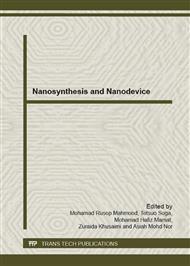[1]
A. T. Afshari, A. Shirpoor, A. Farshid, R. Saadatian, Y. Rasmi, E. Saboory, B. Ilkhanizadeh, and A. Allameh, The effect of ginger on diabetic nephropathy, plasma antioxidant capacity and lipid peroxidation in rats, Food Chem. 101 (2007) 148-153.
DOI: 10.1016/j.foodchem.2006.01.013
Google Scholar
[2]
N. Kota, P. Krishna, and K. Polasa, Alterations in antioxidant status of rats following intake of ginger through diet, Food Chem. 106 (2008) 991−996.
DOI: 10.1016/j.foodchem.2007.07.073
Google Scholar
[3]
S. D. Jolad, R. C. Lantz, G. J. Chen, R. B. Bates, and B. N. Timmermann, Commercially processed dry ginger (Zingiber officinale): Composition and effects on LPS-stimulated PGE2 production, Phytochemistry. 66 (2005) 1614−1635.
DOI: 10.1016/j.phytochem.2005.05.007
Google Scholar
[4]
F.L. Yen, T.H. Wua, L.T. Lin, T.M. Cham, and C. -C. Lin, Nanoparticles formulation of Cuscuta chinensis prevents acetaminophen-induced hepatotoxicity in rats, Food Chem Toxicol. 46 (2008) 1771-1777.
DOI: 10.1016/j.fct.2008.01.021
Google Scholar
[5]
P. Y. Ma, Z. Y. Fu, Y. L. Su, J. Y. Zhang, W. M. Wang, H. Wang, Y. C. Wang, and Q. J. Zhang, Modification of physicochemical and medicinal characterization of Liuwei Dihuang particles by ultrafine grinding, Powder Technol. 191 (2009) 194-199.
DOI: 10.1016/j.powtec.2008.10.008
Google Scholar
[6]
Y. Su, Z. Fu, C. Quan, and W. Wang, Fabrication of nano Rhizama Chuanxiong particles and determination of tetramethylpyrazine, T Nonferr Metal Soc. 16 (2006) s393-s397.
DOI: 10.1016/s1003-6326(06)60218-5
Google Scholar
[7]
L. Zhang, H. Xu, and S. Li, Effects of micronization on properties of Chaenomeles sinensis (Thouin) Koehne fruit powder, Innov Food Sci Emerg. 10 (2009) 633-637.
DOI: 10.1016/j.ifset.2009.05.010
Google Scholar
[8]
X. Zhao, Q. Ao, F. Du, J. Zhu, and J. Liu, Surface characterization of ginger powder examined by X-ray photoelectron spectroscopy and scanning electron microscopy, Colloid Surface B. 79 (2010) 494-500.
DOI: 10.1016/j.colsurfb.2010.05.019
Google Scholar
[9]
M.S. Su and J. L. Silva, Antioxidant activity, anthocyanins, and phenolics of rabbiteye blueberry (Vaccinium ashei) by-products as affected by fermentation, Food Chem. 97 (2006) 447-451.
DOI: 10.1016/j.foodchem.2005.05.023
Google Scholar
[10]
K. S. Kim, W.G. Hwang, H.G. Jang, B.G. Heo, M. Suhaj, H. Leontowicz, M. Leontowicz, Z. Jastrzebski, Z. Tashma, and S. Gorinstein, Assessment of Indigo (Polygonum tinctorium Ait. ) water extracts' bioactive compounds, and their antioxidant and antiproliferative activities, LWT - Food Sci Technol. 46 (2012).
DOI: 10.1016/j.lwt.2011.11.017
Google Scholar
[11]
T. Yamaguchi, H. Takamura, T. Matoba, and J. Terao, HPLC method for evaluation of the free radical-scavenging activity of foods by using 1, 1-diphenyl-2-picrylhydrazyl, Biosci Biotech Bioch. 62 (1998) 1201-1204.
DOI: 10.1271/bbb.62.1201
Google Scholar
[12]
I. F. F. Benzie and J. J. Strain, The Ferric reducing ability of plasma (FRAP) as a measure of antioxidant power,: the FRAP assay, Anal Biochem. 239 (1996) 70 -76.
DOI: 10.1006/abio.1996.0292
Google Scholar
[13]
Y. Y. Lim, T. T. Lim, and J. J. Tee, Antioxidant properties of several tropical fruits: A comparative study, Food Chem. 103 (2007) 1003-1008.
DOI: 10.1016/j.foodchem.2006.08.038
Google Scholar


